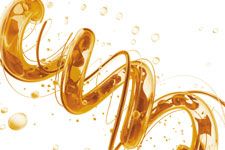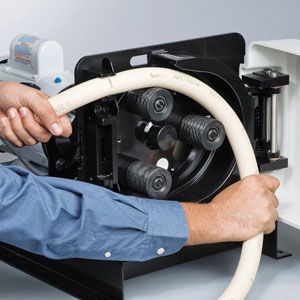Selecting and Installing Peristaltic Pump Tubing
Proper selection and installation optimizes fluid system performance.
arleksey/Shutterstock.com

The heart of any peristatic pump is the tubing. It is the primary fluid-contacting part and is occluded by the pump rotor and housing, thus providing the pumping action. With some attention when installing or changing tubing and proper tubing material selection, the pumping system can be optimized.
Tubing installation
Proper tube loading can improve the tubing life and overall pumping performance and accuracy. It can also provide consistency between tubing changes by implementing a standardized process for tubing installation.
Figure 1. Stretch tubing slightly while loading it into the peristaltic pump, and make sure it is in the center of the roller and occlusion bed. Figure is courtesy of the author.

Match the pump to the tubing size. Peristaltic pumps require specific tubing sizes-determined by the inside diameter (ID), the outside diameter (OD), and the wall thickness-to operate correctly. Using the wrong size in a pump can lead to improper function of the retaining mechanism, no pumping action, and even premature failure of the tubing. Use of precision peristaltic pump tubing in the right size can ensure that the pump system will operate correctly.
Follow the natural curvature. During manufacturing of the tubing, it is laid up in a coil, which imparts a natural curvature to the tubing. When loading the tubing into a pump, allowing it to follow its natural curvature with the curvature of the occlusion bed will improve tubing performance. If the tubing is twisted, it can roll to one side of the rotor and may strike the rotor place, thus damaging the tubing.
Stretch the tubing. As the tubing is being loaded, giving it a slight stretch by pulling it gently by hand, as shown in Figure 1, will improve performance. Stretching eliminates the potential for excess bunching of tubing at the discharge side of the pump when starting up, which can cause early failure and decrease accuracy of the pump system. Do not overstretch the tubing, which will change its dimensions and thus affect flow rates.
Center the tubing. When loading tubing, make sure it is in the center of the roller and occlusion bed. If installed off center, or with a twist, it can be driven into the rotor plate, causing damage to the tubing.
Following these simple loading steps can ensure consistent tube loading and serve as a standardized process.
Tubing selection
Proper tubing selection, which is detailed in the following section, will ensure that the tubing matches the requirements for the fluid system design. When choosing the right tubing for an application, there are many factors to consider. To make the process simple, use the acronym STAMP-size, temperature, application, media, and pressure-to help remember each factor.
Size. The ID, OD, and wall thickness of the tube are significant factors in pressure and vacuum ratings and must be considered in the decision. The tolerances are also a concern for optimal operation in peristaltic pumps. The typical tolerance of off-the-shelf nominal tubing can be greater than +/-5%. If this non-precision tubing is used, it can cause problems with volumetric accuracy, suction lift, or pressure; poor tubing life can also be a result.
Temperature. Operating temperature is most often considered due to its importance, but cleaning temperature, ambient temperature, and the overall temperature fluctuation must also be considered. Sudden changes or extreme temperatures can negatively affect performance and cause premature failures. A higher cost material has traditionally been the only option to improve performance in extreme temperatures. With advances in manufacturing capabilities, however, multilayer products are available that can help ease this cost while still meeting the performance expectations.
Application. Understanding the full scope of the application is the most Âcomplex portion of the Âselection process and most often overlooked. Regulatory concerns are always at the top of the list. Understanding what documentation is needed and what special regulations must be complied with are important; different compliance concerns may call for different material selection. Tubing materials and formulas can be tested to ensure they comply with the appropriate criteria.
Knowing the dynamics (e.g., flow rate, pressure, or viscosity) of the application will assist with material selection for clarity, durometer (relative hardness), flexural fatigue, abrasion resistance, spallation (the tendency of materials to release particulates due to impact or stress), and particulates (pyrogens). There are materials available to combat each of these concerns individually and Âmulti-layer options to solve a mix of these factors.
Media. Knowing the media or fluid being transported and its characteristics, such as extractables level, the tendency for adsorption or absorption of fluid into the tubing material, and the tendency of media to entrap particulates, is necessary to assure high purity. Different chemicals attack various materials at different rates, so understanding all the chemicals that might be used in the tubing will help with proper selection. Cleaning agents are often the most aggressive fluids used; be aware of any chemical reactions which might be caused by cleaning or sterilizing agents. Often overlooked are the ambient chemicals (e.g., solvents) present in the atmosphere, either present in the air surrounding the tubing product or dripping by way of leaks or condensation creation. The effect of these chemicals on the tubing should also be considered. If the fluid is very aggressive, a more resistant material can be used, or multilayer tubing can be selected that assists with barrier protection but is not as costly as tubing made completely from a more resistant material.
Some tubing materials can be produced at tighter tolerances for tighter fitting connections to avoid leak points. Others can be produced with a smoother inner surface for better flushing. Understanding the fluid being conveyed can help maximize the efficiency of your project to assist with easier flushing and avoidance of costly leaks.
Safety also plays a role with material choice. Some requirements mandate viewing the fluid being conveyed. This means the material must have a sufficient level of clarity to see the fluid path and distinguish if any particulates are present. Other options require identifying marks for various chemicals through the use of colored tubing products or specific marking text. Use of these marks is a growing trend in efforts to further company’s safety improvements.
Pressure. Vacuum and positive pressure create stress on any tubing product. Ignoring these factors can create hazardous conditions during product use. Use temperature also has a significant effect on the pressure rating for materials, and proper measures must be taken. Changing the wall thickness can help increase pressure rating, as can reducing the overall OD and ID. If these measures are not an option, multilayer products of various materials can help handle the desired pressure as well as maintain the proper condition in the fluid path.
Pressures created during normal operation are not the only factor when selecting the proper tubing. Cleaning or sterilization cycles can create the most extreme pressure conditions and must be considered during the selection.
Summary
The peristaltic pump system can be optimized with proper tubing installation material selection that takes into account the size of the tubing and the temperature, application, media, and pressure of the system. When selecting a tubing product, quality is of the utmost importance. Do not shy away from asking the manufacturer about their quality process, and take a plant tour to see how a product is designed and produced. Should something ever go wrong in the field, a manufacturer should have the supporting quality documentation.
Article Details
Pharmaceutical Technology
Vol. 42, No. 1
Pages: 38–39
Citation
When referring to this article, please cite it as G. Johnson, "Selecting and Installing Peristaltic Pump Tubing," Pharmaceutical Technology 42 (1) 2018.
About the author
Gregg Johnson is global senior product manager for Masterflex and Ismatec Product Lines, Cole-Parmer.

Drug Solutions Podcast: A Closer Look at mRNA in Oncology and Vaccines
April 30th 2024In this episode fo the Drug Solutions Podcast, etherna’s vice-president of Technology and Innovation, Stefaan De Koker, discusses the merits and challenges of using mRNA as the foundation for therapeutics in oncology as well as for vaccines.
Entering New Domains for 3D Printing of Drug Products
April 6th 20253D printing of personalized medications is currently possible under existing compounding regulations, offering enhanced process control through automation. But new legislation coming in 2025 will allow 3D printing as part of a distributed manufacturing framework.